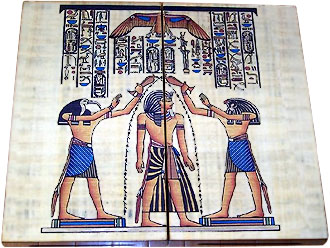|
| Magriel's NYT Columns |
 Backgammon is considered the world’s oldest board game. Early forerunners of the game date back 5,000 years, to the Sumer civilization in southern Mesopotamia, now Iraq. The ancient Egyptians played a version of the game. Indeed, the tomb of Tutankhamen, from the 15th century B.C., contains relics of a game similar to backgammon.
Backgammon is considered the world’s oldest board game. Early forerunners of the game date back 5,000 years, to the Sumer civilization in southern Mesopotamia, now Iraq. The ancient Egyptians played a version of the game. Indeed, the tomb of Tutankhamen, from the 15th century B.C., contains relics of a game similar to backgammon.
Today backgammon is played widely throughout all the Middle Eastern countries bordering the Mediterranean. In other parts of the Middle East, such as Saudi Arabia, the game is just now beginning to take hold. One enthusiastic Middle Eastern player recently demonstrated his strategic skill in the diagrammed position.
Earlier in the game, Black (the player), had been doubled. Black now is in great jeopardy — White threatens to cover his exposed blot on the 20-point and so control five points in a row. The 5-point prime thus formed would leave Black’s 3 back men on the 23-point with little hope of ever escaping.
|
| Black to play 4-1. |
Black’s top priority, however, should not be to anticipate the prime — but to prevent it. The correct play is 6/1*, hitting White on the 1-point. By taking strong positive action, Black reduces White’s immediate chance of forming the prime. To see why, let us count White’s favorable rolls in each case:
- Without hitting, White will be able to safely cover the 20-point with 1’s, 3’s, and 8’s for a total of 24 combinations out of 36.
- By hitting, only six combinations (5-3, 5-1, 3-3, 1-1) allow White to both come in and safely cover.
Without hitting
8/4, 23/22
Hitting
6/1*
The experienced player will perceive this difference without an exact mathematical calculation because he recognizes the “duplication principle” at work. White primarily needs 1’s and 3’s to cover. By hitting, White may be forced to use these same numbers to reenter instead. White’s chances are thus reduced because the numbers he needs to reenter and to cover are duplicated.
Notice that Black need not fear being hit on the 1-point; in fact he might welcome it. If White hits without covering, Black’s chance of hitting the crucial blot on the 20-point will be significantly increased.
If Black succeeds in wresting control of this vital point from White, Black’s game will be just as good as White’s.
In the actual game, White stayed out with 4-4, Black rolled a 3 to hit White, and Black eventually won. By taking the initiative and playing boldly, Black was able to turn around a losing game.
Rollout
 Tom Keith 2013 |
|
Money play Black owns 2-cube Black rolls 4-1 1296 games with VR Checker play: 2-ply Cube play: 3-ply Red |
| 4-1: | Game | G | BG | Equity | ||||
| 1 | 6/1* |
W L |
.2429 .7571 |
.0742 .2386 |
.0020 .0120 | −0.6023 |

| Hit |
| 2 | 23/22, 8/4 |
W L |
.2246 .7754 |
.0496 .2205 |
.0012 .0110 | −0.6527 | (0.0504) | No hit |

|
|

